Washington, DC: Like many tales involving Indians, this one, too, begins with an invite to a WhatsApp group, ‘DC Indian Mangoes’. The group’s moderator is Jay Prakash ‘JP’ Gola, an India-born American, who grew up near Hyderabad and now lives in Ashburn, Northern Virginia, with his wife and two daughters. For the larger part of the year, Gola is a senior technology and business manager at a government-sponsored mortgage company. But for a couple of months every year, he picks up an after-hours gig: importing and distributing multiple varieties of Indian mangoes in the Washington DC-Maryland-Virginia region, or DMV, around the American national capital.
Gola makes two or three trips to the Dulles International Airport in Virginia every week during the Indian mango season, picking up hundreds of boxes shipped on a commercial airline. After a few hours of a nervous wait for clearance from American food and agricultural authorities, he broadcasts the loot on his WhatsApp group: “Hello DC Folks – Are you ready for another round of fresh stock? I have Alphonso, Kesar & Rasalu, Thx.”
Gola keeps a comprehensive Google doc filled with dozens of names and addresses of customers, along with coded requests: 1A for one box of Alphonsos, 3R for three Rasalus. On some days, the code can also expand to Bs (Banganapalle), Hs (Himayat), Ls (Langda), and more.
Then begins a race against time. “Imported mangoes from India are always like a ticking time bomb,” Gola said.

Gola and his sub-distributors, based in other regions in the US, have 48 hours to sell the mangoes, as the famous summer fruit has a short lifespan. Eat it within the first week, and the juicy, lush sweetness might change your life. Wait a little too long, and the fruit will go mushy, bitter, and inedible.
From any metric—including the exorbitantly high cost, the sparse availability, and the short lifespan—the demand for Indian mangoes is almost an irrational love affair. And it has been further complicated by logistical roadblocks, rising tariffs, and, of course, the pandemic. And yet, the affair thrives. Every mango season, retailers and distributors like Gola return to action, rushing to bring the chosen varieties to the small but dedicated pockets of Indian mango lovers in the US.
Many of Gola’s boxes end up in independent ‘desi’ grocery stores across the region. Sometimes, he sets up a temporary stall in accessible areas such as parking lots near local schools or outside supermarket chains. Before the pandemic, he had even set up pickups from his own residence, but was forced to stop after complaints from his neighbours.
Competing with mangoes of Mexican or Central American origin that are available in the US throughout the year, there’s not enough demand for importers like Gola to place Indian mangoes in the biggest grocery stores such as Walmart, Target, and Costco.
There is also a major price barrier: Gola sells a 4 kg box of Alphonso mangoes (each carrying 9-11 pieces) for around $50. The cost of these mangoes in India is around Rs 1,500 ($18). In the US, one can purchase a similar amount of the domestic variety for roughly $10 to $15 (Rs 800 to Rs 1,300).
“There are many, many small businessmen like me,” Gola said. “In 2016, in all of Loudoun County [Northern Virginia], I was the only one. Now, post-pandemic, there are almost five-six importers close by.”
He added with a chuckle, “‘Ghar Ghar Mango’. It’s become like that.”
Also read: Stop this North-South divide over mangoes. The real match is playing out in Bihar and Bengal
Every box is important
On 22 May, a cargo of mangoes arrived at Dulles on an Emirates flight. By 2 pm, Gola’s broker, who primarily functions out of New York, messaged him to confirm that the shipment has received clearance from the United States Department of Agriculture (USDA). But he awaited clearance from the Food and Drug Administration (FDA) before he could distribute or sell the product. By 5 pm, he got this clearance too, and was ready to drive to the airport—a little over 18 kilometres from his office.
Gola takes this drive multiple times a week during the Indian mango season. While he only deals with pickups for the DMV, he has partnered with subcontractors around the country, all of them Indians of Andhra/Telangana origin. They pick up cargo in five other airports close to Indian communities in Atlanta, Dallas, Chicago, Charlotte, and Denver.
During the drive on 22 May, a subcontractor from Denver called him to mention that she plans to keep two boxes of mangoes aside for herself to offer to the deity Hanuman.
Gola keeps close ties with the Indian community in the US, particularly the Telugu-speaking migrants from Andhra Pradesh and Telangana. He grew up in BHEL Township near Hyderabad, where his father worked, and came to the US for his master’s degree in 2000. While rising the ranks at his mortgage company, he started his venture, USMangoWale, in the summer of 2016, ensuring a clear line of delineation between his job and his business.
“Mangoes and mortgages have nothing to do with each other,” he said.
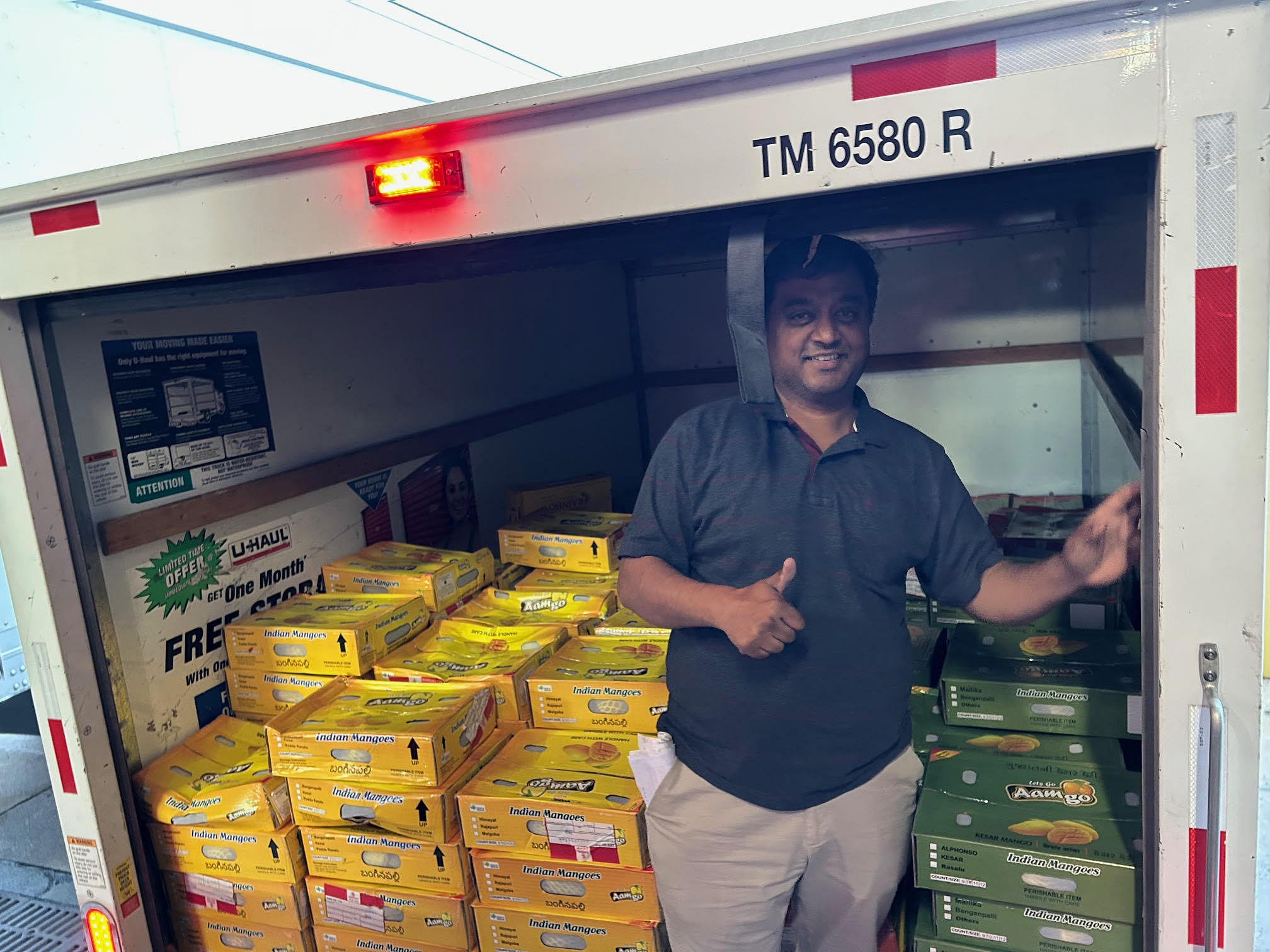
Paying for the fruit itself, the freight fee, customs and agent fees, and other insurances costs Gola a hefty amount for each shipment, justifying the higher markup per box. Still, he considers it to be a profitable venture.
The biggest competitor for Gola—and other small businesses in the Indian mango industry—is Patel Brothers, the largest Indian grocery chain in the US. Founded in 1974 by brothers who moved to America from Bhandu, a village in Gujarat, Patel Brothers now has locations in over 50 locations in 20 states. Another major grocery franchise is India Bazaar, which sells each box for a few dollars cheaper than the smaller distributors.
“Their model doesn’t work out for me,” Gola said. “For Patel Brothers, the mango is just another product on the shelf. It’s like a stock market: if the stock is not moving, it might go for half price.”
Gola prides himself on the freshness and quality of his mangoes. “I have always tagged myself to say, Speed to deliver. Every box is important, because I’m not gonna give damaged goods,” he said.
“It’s the only scientific name I know: Mangifera indica,” he added with a chuckle.
Also read: Gandhi cursed ‘luscious’ mangoes he once loved because he wanted to transcend sex & desire
A long liaison
India has a long liaison with mango, the ‘king of the fruits’. The scientific name, Mangifera indica, also hints toward its connection with the country. It produces an estimated 2.6 crore tonnes of mango annually—almost half of the global market share.
India also consumes most of the mangoes it produces, exporting less than 1 per cent of the fruit grown. Saudi Arabia and the UAE are the largest annual importers of Indian mangoes, while the US ranks third, with its imports valued at around Rs 46 crore.
And within India’s massive landmass lie further wonders—dozens of cultivars vying for the title of ‘emperor among kings’. Among them are Alphonso from the Konkan belt, Kesar from Gujarat, Dasheri and Langda from Uttar Pradesh, Banganapalle from Andhra Pradesh, Badami from Karnataka, and Himayat from the Andhra-Telangana-Tamil Nadu region, also known as Imam Pasand for being a favourite of local royalty.
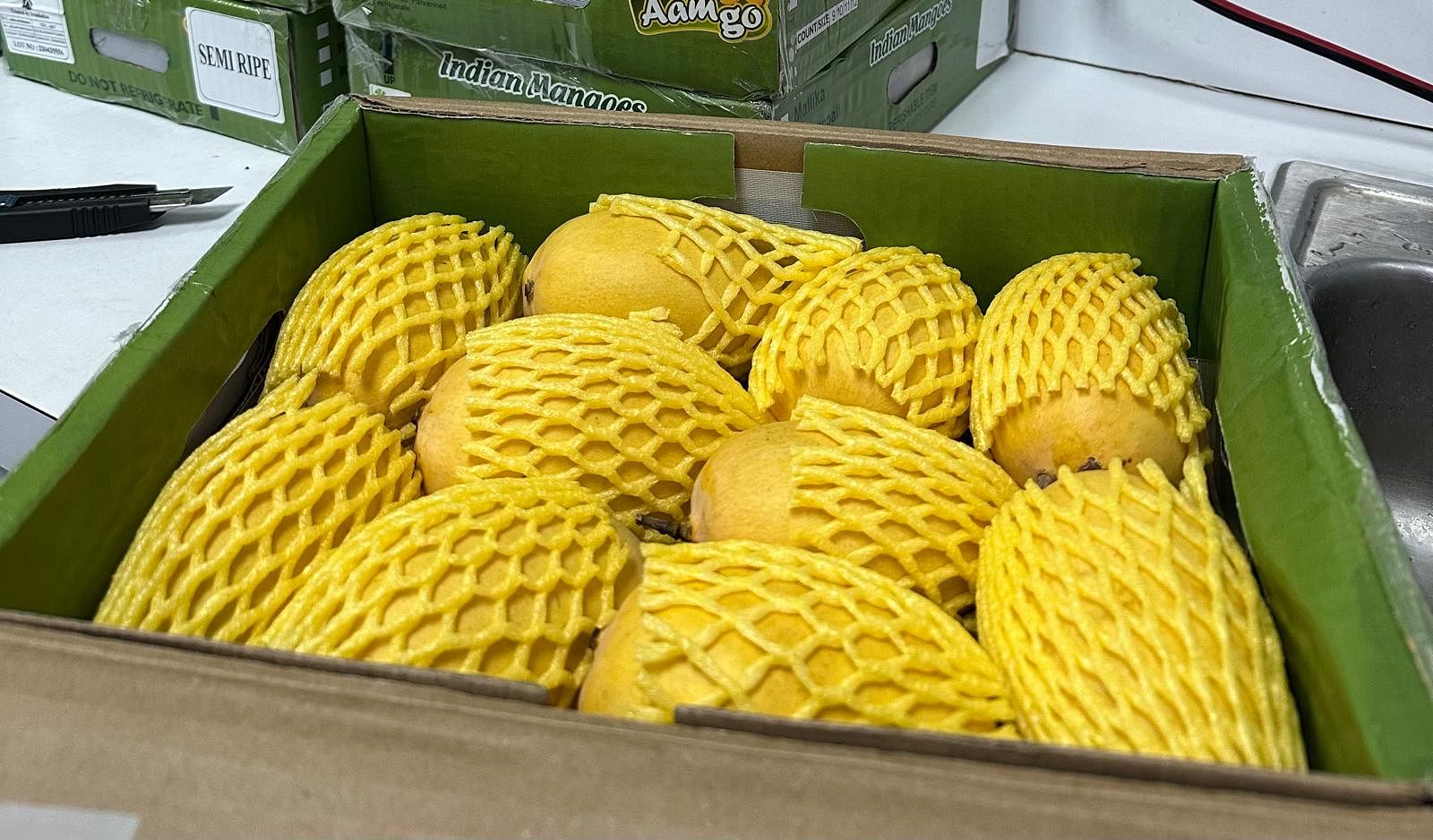
“The mango makes Indians feel special,” said Sopan Joshi, the author of Mangifera indica: A Biography of the Mango (2024). “Since it marks everything from the season to emotional memories, the mangoes with which you grow up become a central element of nostalgia and identity. It is no wonder Indians abroad go to great lengths to score mango varieties of their childhood. It is essential to being Indian.”
For Ashburn-based IT recruiter Apoorva Mishra, who migrated to the US over 30 years ago, the memory of mangoes often pulls her back to India. “I feel most homesick for the festivals, the cultures, the sweets, the atmosphere, and of course, for Indian mangoes,” she said. “They were my favourite food growing up: Banganapalle, Rasalu, Himayat…”
During her first few years in the US, Mishra would settle for the Mexican varieties, which lacked the flavour of Indian mangoes. “It was very sweet, but it didn’t give you the flavour, the aroma of when you open an [Indian] mango.”
Mishra and her family go into mango overdrive when the season begins. “Every time we get a box, we finish it off in days… I am able to recreate some of the childhood memories of mangoes. I tell my kids how we used to eat and enjoy—I tell them how it was growing up back then. It always takes me back in time.”
When Indians like Gola and Mishra first moved to the US, mangoes from the homeland weren’t an option. Indian mangoes had been banned for import since 1989, due to concerns that they would carry pests that would spread and harm American crops. The 18-year ban ended in March 2006, when US President George W Bush visited India to reach the landmark nuclear deal with Prime Minister Manmohan Singh. The two leaders announced bilateral cooperation on several other issues, including investment, trade, environment—and mangoes.
The nuclear deal was sealed in New Delhi with toasts of mango juice. When he tasted an Alphonso, Bush reportedly said that it was “a hell of a fruit”. The first shipment of Alphonsos arrived in New York two months later.
In a parallel ‘swap deal’, India allowed the import of Harley-Davidson motorcycles, which had been previously banned due to emission laws, in exchange for the US allowing the import of Alphonso.
India now exports over 1,000 metric tonnes of mango to the US every year. However, this pales in comparison to the Mexican and Latin American varieties that control over 99 per cent of the market share.
In India, export mangoes are put through the irradiation process, which helps increase the fruit’s shelf life and controls insect and microorganism infestation. The process is done at various USDA-approved irradiation centres in Mumbai, Bengaluru, and Ahmedabad, before the mangoes are checked by the India-based USDA agent and loaded in crates on international flights, to travel the nearly 13,000–kilometre journey to the US.
Also read: Om Sweets’ Pakistan to Gurugram journey—3 brothers turned doda barfi into a Rs 600 cr empire
Shocks to the system
Before he gets to the airport, Gola drives to the nearest U-Haul location, switching to a rental truck. The boxes have been waiting for him at a cargo warehouse near the airport. Once the mango-laden flight lands on US soil, three things must happen: the USDA check, the FDA review, and a release from Customs and Border Patrol (CBP). When this is done, the shipment is collected by the ground handling crew, and Gola is on the clock. Any delays in picking up the cargo before the end of the day can cost him up to $1,000 in fines.
At times, the FDA has exercised its right to randomly test the shipment, keeping the fruit at its facility for as long as 10 days. By the time Gola gets the mangoes back in such cases, they are rotten and have to be disposed of.
The distributor is particularly perplexed by the second USDA check upon arrival in the US. “They already have a [USDA] officer in India—why should they double–check here? I mean… it’s just a mango.”
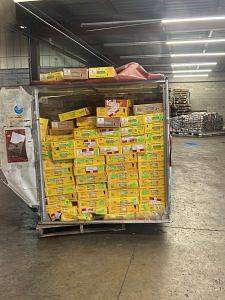
Earlier this year, mango importers had to face a novel problem. On 2 April 2025—at the cusp of mango harvest season in India—US President Donald Trump enacted a series of protective tariffs on nearly all imported goods. The result was a 26 per cent tariff on Indian mango, to be paid by importers like Gola.
“We were all in shock. 26 per cent was about $3-4 more per box, and when I started off this season around 10 April, I had to account for it,” he said. Within days, however, Trump rolled the tariffs back to a “standard” 10 per cent.
But the trials of the Indian mango trade network were far from over. Last month, USDA authorities rejected 15 shipments of Indian mangoes at airports in Los Angeles, San Francisco, and Atlanta. Citing ‘documentation errors’ in the PPQ203 form for air shipments. The error was related to the irradiation process, overseen by a USDA-appointed officer in Mumbai.
Exporters in India faced losses of up to $500,000 (over Rs 4.3 crore) as they were forced to destroy the perishable cargo. The incident raised a considerable row. Gola asserts that, just days later, a USDA chief flew to Mumbai to meet members of the Agricultural & Processed Food Products Export Development Authority (APEDA) council and dozens of exporters. The irradiation centres in India were closed for two days to rectify the issue.
Gola was fortunate not to have incurred any losses due to the incident, as he had no shipments coming in on that day. “This was the first time something like this has happened,” he said.
At the airport, Gola’s goods await at a private storage facility. He pays around $700 to the facility, the CBP, the FDA, and his broker—and waits restlessly for clearance, speaking to associates in other cities on the phone.
At 7 pm, he is let in. With the help of a couple of his associates, Gola unloads some 360 boxes, each weighing about 3.5 kg, loading Banganapalle, Himayat, and Kesar into the back of his U-Haul truck. There are other shipments waiting to be collected in the warehouse, including more crates of Indian mangoes and flowers from Central Asia. Gola has also seen animals (mostly dogs) waiting in the cargo section, as well as corpses of Americans who died abroad.
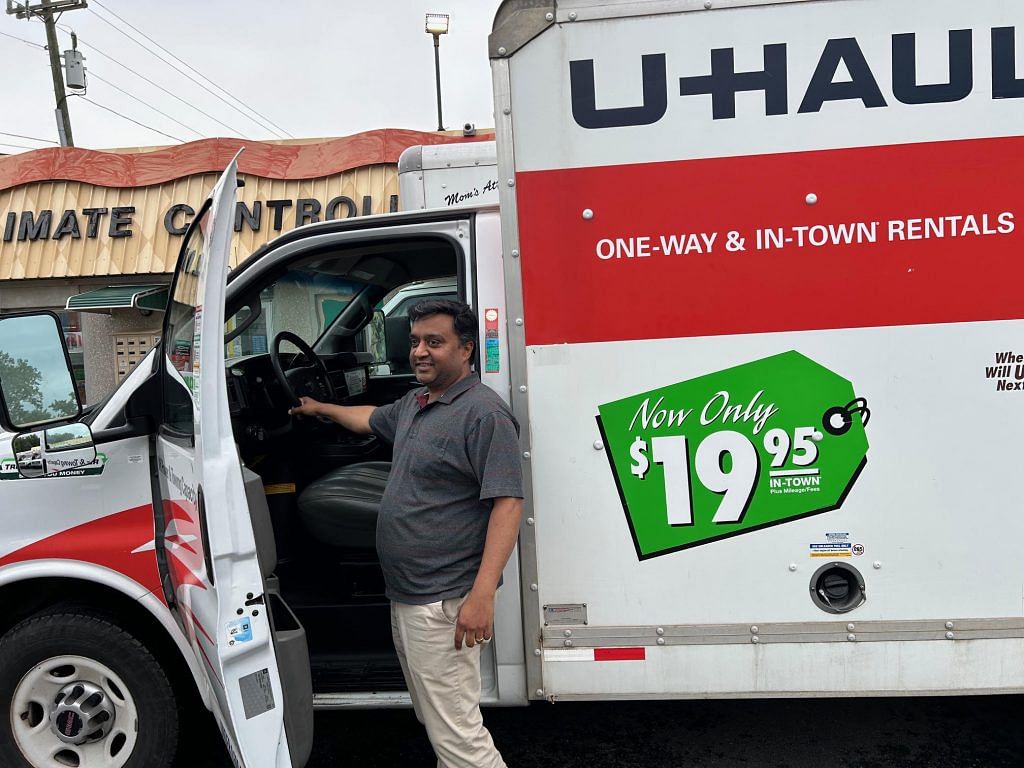
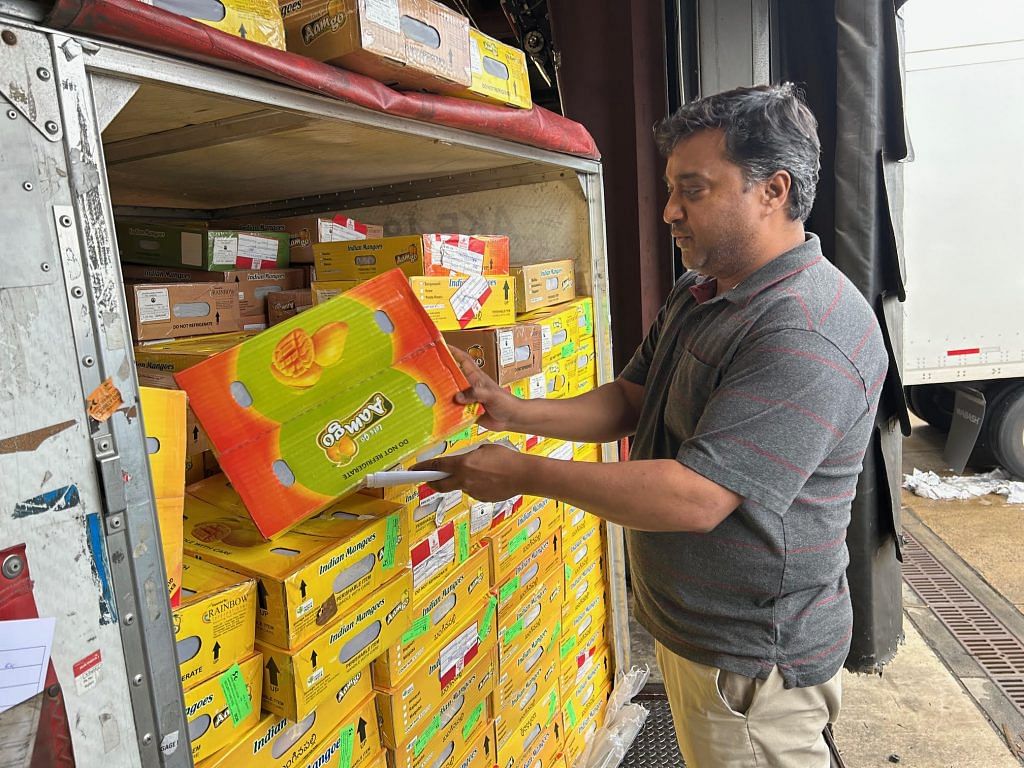
Before he’s done, a couple of young men of Indian origin arrive at the warehouse, looking for their own shipment of Indian mangoes. They work for a competing small business, and are expecting about 350 boxes of Banganapalle that arrived on the same Emirates flight. Both men are from Vijayawada in Andhra Pradesh, and speak to Gola in Telugu. Their mangoes will be sold for a slightly higher cost than Gola’s—$55 per box—for good reason, as they will be travelling that very night to distribute the stock to the Indian community in North Carolina, over a five–hour drive away.
Gola, however, enjoys the large network he has built in the DMV, where he has thousands of contacts in various WhatsApp groups, waiting for his go-ahead. “As admin, I have to manage these groups. No ‘good morning – good evening’ messages,” he said.
Many of his customers live around Virginia’s Loudoun County, where the 2020 median household income of $147,111 was the highest in the nation. In 2022, Indian Americans were observed to be among the highest-earning ethnic groups in the United States, earning a median income of $145,000 per household against a national average of $77,700.
While many from the Indian diaspora can afford to splurge on the fruit, Gola has discovered that the same appreciation hasn’t extended to other ethnic groups in the US.
“There is no connection for them. Ideally, I want to sell these mangoes to non-Indians, too, but the amount of money and energy to market it won’t be worth the effort. I’d rather focus on an Indian consumer base, and let that happen naturally,” he said.
One of Gola’s customers is Krish S—another Hyderabad transplant now in Frederick, Maryland—who first came to the US in 2005 and now works in an IT company. Krish tells me that the most “heartfelt thing” for him has been seeing his four-year-old daughter, who was born in the US, develop a love for Indian mangoes, too.
“Getting them from India, getting it safely wrapped, it’s a huge task,” Krish said. “But for anyone who has grown up in India and come here, they won’t mind spending on this. The mangoes here from Mexico or Cuba are nowhere close. They just don’t cut it. Our Indian stuff is the gold standard. That is the highest parameter.”
Also read: ‘Mango has to survive’— this juicy Delhi book launch was all about India’s favourite fruit
An emotional tether
The mangoes found in the markets or over the internet are, at best, an approximation of the real varietal taste, said Sopan Joshi.
“If you wish to truly enjoy your mango, it’s better to travel to where it is grown; if you are really serious about it, then make friends with good growers. The mango is the ultimate fruit [and tree] of connection and connectedness in India—socially, emotionally, culturally, ecologically,” Joshi added.
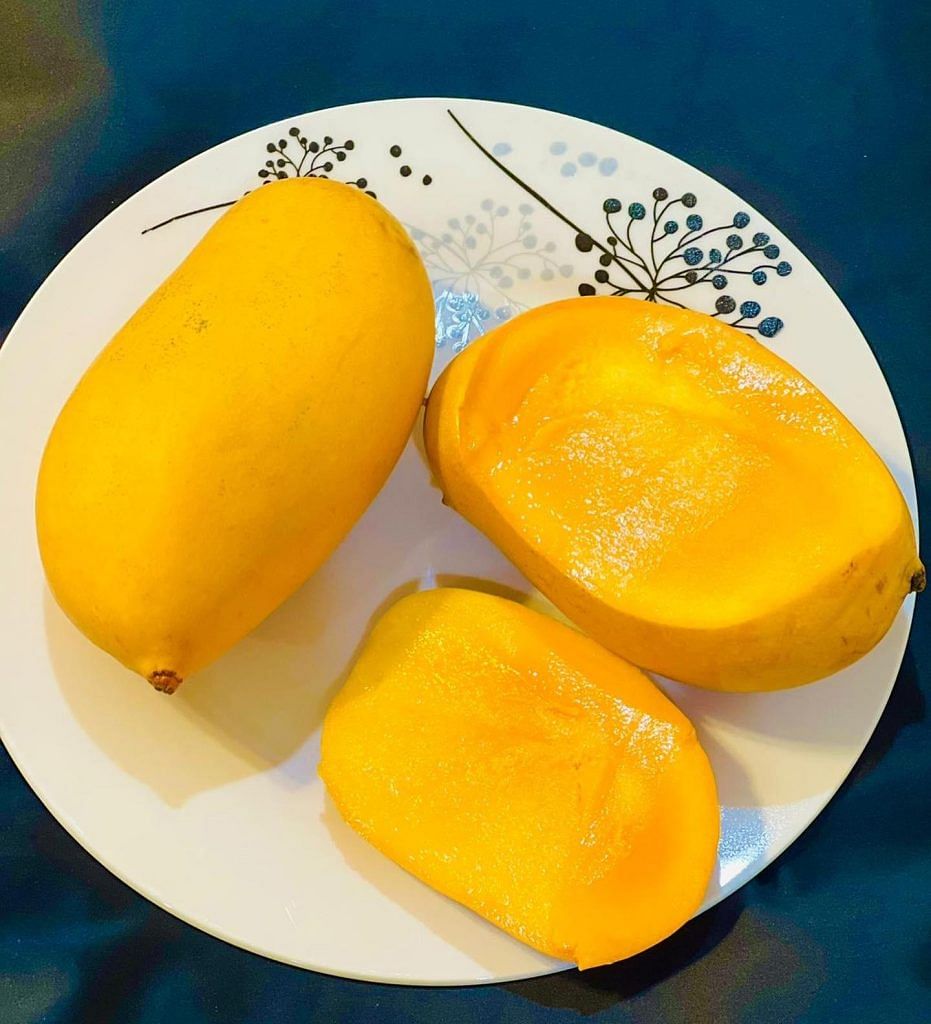
And yet, for mango lovers abroad, oceans away from the source of their favourite fruit, the imported fruit helps sustain a special bond with their motherlands.
“The nostalgia… Nothing beats hamara desh (our country). The flavour is in the smell itself. Even when I was a school-going kid [in India], I remember the smell of my mom cutting it for me and my sister to gorge on, after lunch. That is an emotion. Millions of Indians feel it,” Krish said.
Gola agrees that this emotion is the key.
“It’s all about how you were brought up,” he said. “How your Dadaji and Nanaji talked about the mango that comes from their yard. Everybody talks about that. The mango is more of an emotion than anything else. There is so much difference in the fragrance. It’s not something chemical—it’s the soil [of India].”
In the US, fans of Indian mangoes stay connected through this emotional tether. “There are some things you cannot break apart. You cannot throw the apple too far from the tree,” he added.
The only thing Gola got wrong in the idiom is the fruit.
Karan Madhok is a journalist and editor. He is the author of ‘Ananda: An Exploration of Cannabis in India’ and ‘A Beautiful Decay’. He tweets @karanmadhok1 and is on Instagram @karanmadhok.
(Edited by Prasanna Bachchhav)




